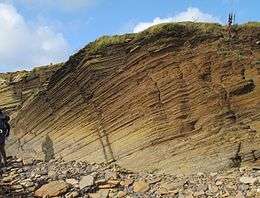Caithness Flagstone Group
| Caithness Flagstone Group Stratigraphic range: Eifelian (Devonian) | |
|---|---|
 The Sandwick Fish Bed | |
| Type | Group |
| Unit of | Old Red Sandstone Supergroup |
| Sub-units | Upper Stromness Flagstone Formation, Lower Stromness Flagstone Formation |
| Underlies | Eday Group |
| Overlies | Yesnaby Sandstone Group |
| Thickness | over 2000 m |
| Lithology | |
| Primary | sandstone |
| Other | mudstone, siltstone |
| Location | |
| Region | Orkney, Shetland, Highland |
| Country | Scotland |
| Extent | Moray Firth to Shetland |
| Type section | |
| Named for | Caithness |
The Caithness Flagstone Group is a Devonian lithostratigraphic group (a sequence of rock strata) in northern Scotland. The name is derived from the traditional county of Caithness where the strata are well exposed, especially in coastal cliffs.[1]
Outcrops
These rocks are exposed, along the Moray Firth and along the eastern side of Sutherland and throughout Caithness, across Orkney and, to a rather lesser extent, in Shetland.
Lithology and stratigraphy
The Group comprises the Upper Stromness Flagstone Formation and the Lower Stromness Flagstone Formation laid down in the lacustrine Orcadian Basin during the Eifelian Stage of the Devonian Period.
It contains numerous rhythmnic sequences of mudstone, limestone, siltstone and sandstone of which there are 25 and 38 in the constituent lower and upper formations respectively. A conglomerate occurs at the base of the lower formation. A notable element is the Sandwick Fish Bed which defines the junction of the two formations and from which a diverse range of fish fossils have been recovered.[2]
References
- ↑ http://www.bgs.ac.uk/Lexicon/lexicon.cfm?pub=CNFL (BGS on-line lexicon of rock units)
- ↑ British Geological Survey 1:50,000 scale geological map (Scotland) sheets 109, 110, 115 & 116, and 1:100,000 scale Orkney Islands (special sheet)